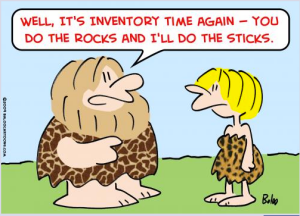Tackling the E-commerce Inventory Beast: 5 Critical Components

Managing inventory is an essential task for any online store. Buying too many units of an individual item on faith risks tying up precious capital. At the same time telling potential customers the blue widget they want is on backorder because having misjudged demand you understocked blue widgets can result in the loss of sales. Unlike in past when the only widget store in town could rely on customers waiting for their back-ordered item because they had nowhere else to go, the internet it makes it too easy for customers to go to another vendor with their item in stock and available today.
SalesWarp Vice President of Marketing David Anderson has an interesting article over at Ecommerce Insiders concerning a vexing problem facing anyone selling merchandise online:
Tackling the E-commerce Inventory Beast: 5 Critical Components
What if every time you checked out at the supermarket, the cashier had to log all of your shopping cart contents, look up the price for each item in a binder, update the list of items remaining in the store, and then tally your bill by hand.
Would you even go back to the store? The checkout line would snake through the aisles, extend outside, and wrap around the block. Customers would waste hours waiting in line while the supermarket would squander valuable resources trying to execute processes such as this.
Ok, this is a little extreme, but you get the picture. Managing an online store is not much different. Even with all of our technology, cumbersome and inefficient manual processes continue to plague the retail and E-commerce industries, and specifically their inventory management systems. Importing products from a single warehouse, let alone several, is a time-consuming task.
Then, having to manage your inventory in real-time as purchases happen to avoid out-of-stocks and cancellations can be just as stressful and resource-intense.

Managing your inventory in real-time as customers make their purchases is not the only stressful thing about inventory management. Warehouse Integration, Product and Inventory Management and Inventory Tracking are a some of the most time-consuming and labor-intensive tasks an online retailer faces.
David’s article includes a list of best practices that Dave and the SalesWarp Marketing Team have identified critical components of their all-in-one E-commerce Storefront Management System to help simplify and streamline inventory management:
Warehouse Integration – Getting products from your suppliers to your online store can be a long and arduous process. The files are never complete, data is missing, headings are mislabeled…we’ve all been there. Having a system that is able to connect to each of your suppliers, import and correct all the product data so you can publish to your online stores, without having to do anything manually is a real time-saver, especially when managing multiple suppliers and stores.
Inventory / Product Management – Being able to set inventory levels and manage product threshold limits to ensure products are removed from your sites automatically when these limits are reached provides incredible peace-of-mind knowing that there will be no more out-of-stocks, cancelled orders. Your system should also give you the ability to select the primary warehouse for fulfillment if you have multiple suppliers or warehouses with the same product lines. Inventory Tracking – A complete E-commerce system that can give you a snapshot of your total inventory for every supplier – the number of products, what’s published, not unpublished, blocked, skipped, available – in real-time can have tremendous value. No more searching for the latest spreadsheets.
